
Tiền nhiệm Ulysses S. Grant
Kế nhiệm James A. Garfield
Đảng Cộng hòa
Sinh 4 tháng 10, 1822
Mất 17 tháng 1, 1893 (70 tuổi)
Phu nhân Lucy Webb Hayes
Rutherford Birchard Hayes (4 tháng 10 năm 1822 - 17 tháng 1 năm 1893) là một nhà chính trị, luật sự, nhà lãnh đạo quân sự Hoa Kỳ và là tổng thống thứ 19 của Hoa Kỳ (1877–1881). Hayes thắng cử nhiệm kỳ tổng thống nhờ chỉ hơn có một phiếu trong cuộc bầu cử gây tranh cãi năm 1876. Vợ ông, bà Lucy Hayes được xem là Đệ nhất phu nhân Hoa Kỳ đầu tiên.
Binh nghiệp:
Trong cuộc nội chiến Hoa Kỳ (1861-1865) , ông được cử làm thiếu tướng quân đội Liên bang miền Bắc.
Ông đã tham chiến trong Chiến dịch Thung lũng năm 1864. Ông là vị tướng thứ ba của cuộc nội chiến leo thang lên chức tổng thống (sau Andrew Johnson và Ulysses Grant, 2 người tiền nhiệm ông).
Kế Nhiệm: James A. Garfield
Rutherford B. Hayes
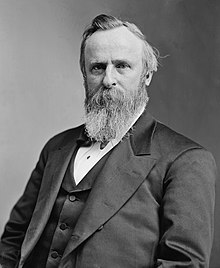 |
| 19th President of the United States |
In office
March 4, 1877 – March 4, 1881
Vice President William Wheeler
Preceded by Ulysses Grant
Succeeded by James Garfield
In office
January 10, 1876 – March 2, 1877
Lieutenant Thomas Young
Preceded by William Allen
Succeeded by Thomas Young
In office
January 13, 1868 – January 8, 1872
Lieutenant John Lee
Preceded by Jacob Cox
Succeeded by Edward Noyes
Member of the U.S. House of Representatives
In office
March 4, 1865 – July 20, 1867
Preceded by Alexander Long
Succeeded by Samuel Cary
Personal details
Born Rutherford Birchard Hayes
October 4, 1822
Died January 17, 1893 (aged 70)
Resting place Spiegel Grove State Park
Political party Republican (1854–1893)
Other political
affiliations Whig (Before 1854)
Spouse(s) Lucy Webb
Children Birchard, Webb, Rutherford, Joseph, George, Fanny, Scott, Manning
Profession Lawyer
Religion Methodism
Military service
Allegiance
Service/branch
Years of service 1861–1865
Rank Brevet major general
Unit
Battles/wars American Civil War
Rutherford Birchard Hayes (October 4, 1822 – January 17, 1893) was the 19th President of the United States (1877–1881). As president, he oversaw the end of Reconstruction and the United States' entry into the Second Industrial Revolution. Hayes was a reformer who began the efforts that led to civil service reform and attempted, unsuccessfully, to reconcile the divisions that had led to the American Civil War fifteen years earlier.
Born in Delaware, Ohio, Hayes practiced law in Lower Sandusky (now Fremont) and was city solicitor of Cincinnati from 1858 to 1861. When the Civil War began, Hayes left a successful political career to join the Union Army. Wounded five times, most seriously at the Battle of South Mountain, he earned a reputation for bravery in combat and was promoted to the rank of major general. After the war, he served in the U.S. Congress from 1865 to 1867 as a Republican. Hayes left Congress to run for Governor of Ohio and was elected to two consecutive terms, serving from 1868 to 1872. After his second term had ended, he resumed the practice of law for a time, but returned to politics in 1876 to serve a third term as governor.
In 1876, Hayes was elected president in one of the most contentious and hotly disputed elections in American history. Although he lost the popular vote to Democrat Samuel J. Tilden, Hayes won the presidency by the narrowest of margins after a Congressional commission awarded him twenty disputed electoral votes. The result was the Compromise of 1877, in which the Democrats acquiesced to Hayes's election and Hayes accepted the end of military occupation of the South.
Hayes believed in meritocratic government, equal treatment without regard to race, and improvement through education. He ordered federal troops to quell the Great Railroad Strike of 1877 and ordered them out of Southern capitals as Reconstruction ended. He implemented modest civil service reforms that laid the groundwork for further reform in the 1880s and 1890s. Hayes kept his pledge not to run for re-election. He retired to his home in Ohio and became an advocate of social and educational reform.
Family and early life
Childhood and family history
Rutherford Birchard Hayes was born in Delaware, Ohio, on October 4, 1822, the son of Rutherford Hayes and Sophia Birchard. Hayes's father, a Vermont storekeeper, took the family to Ohio in 1817 but died ten weeks before his son's birth. Sophia took charge of the family, bringing up Hayes and his sister, Fanny, the only two of her four children to survive to adulthood.[1] She never remarried.[2] Sophia's younger brother, Sardis Birchard, lived with the family for a time.[3] Always close to Hayes, Sardis Birchard became a father figure to him, contributing to his early education.[4]
Through both his father and mother, Hayes was of New Englandcolonial ancestry.[5] His earliest American ancestor emigrated toConnecticut from Scotland in 1625.[6] Hayes's great-grandfather, Ezekiel Hayes, was a militia captain in Connecticut in the American Revolutionary War, but Ezekiel's son (Hayes's grandfather, also named Rutherford) left his New Haven home during the war for the relative peace of Vermont.[7]His mother's ancestors arrived in Vermont at a similar time, and most of his close relatives outside Ohio continued to live there. John Noyes, an uncle by marriage, had been his father's business partner in Vermont and was later elected to Congress.[8] His first cousin, Mary Jane Noyes Mead, was the mother of sculptor Larkin Goldsmith Mead and architect William Rutherford Mead.[8]John Humphrey Noyes, the founder of the Oneida Community, was also a first cousin.[9]
[edit]Education and early law career
Hayes attended the common schools in Delaware, Ohio, and enrolled in 1836 at the Methodist Norwalk Seminary in Norwalk, Ohio.[10] He did well at Norwalk, and the following year transferred to a preparatory school in Middletown, Connecticut, where he studied Latin and Ancient Greek.[11]Returning to Ohio, Hayes entered Kenyon College in Gambier in 1838.[12] He enjoyed his time at Kenyon, and was successful scholastically;[13] while there, he joined several student societies and became interested in Whig politics.[14] He graduated with highest honors in 1842 and addressed the class as its valedictorian.[15]
After briefly reading law in Columbus, Ohio, Hayes moved east once more to attend Harvard Law School in 1843.[16] Graduating with an LL.B, he was admitted to the Ohio bar in 1845 and opened his own law office in Lower Sandusky (now Fremont).[17] Business was slow at first, but he gradually attracted a few clients and also represented his uncle Sardis in real estate litigation.[18] In 1847, Hayes became ill with what his doctor thought to be tuberculosis. Thinking a change in climate would help, he considered enlisting in the Mexican–American War, but on his doctor's advice he instead visited family in New England.[19] Returning from there, Hayes and his uncle Sardis made another long journey to Texas, where Hayes visited with Guy M. Bryan, a Kenyon classmate and distant relative.[20] Business remained meager on his return to Lower Sandusky, and Hayes decided to move to Cincinnati.[21]
Cincinnati law practice and marriage
Hayes moved to Cincinnati in 1850, and opened a law office with John W. Herron, a lawyer from Chillicothe.[22][a] Later, Herron joined a more established firm and Hayes formed a new partnership with William K. Rogers and Richard M. Corwine.[24] Hayes found business better in Cincinnati, and enjoyed the social attractions of the larger city, joining the Cincinnati Literary Society and the Odd Fellows Club.[25] He also attended the Episcopal Church in Cincinnati but did not become a member.[25] Hayes courted his future wife, Lucy Webb, during his time there.[26] His mother had encouraged him to get to know Lucy years earlier, but Hayes had believed she was too young and focused his attention on other women.[27] Four years later, Hayes began to spend more time with Lucy. They became engaged in 1851 and married on December 30, 1852, at the house of Lucy's mother.[26] Over the next five years, Lucy gave birth to three sons: Birchard Austin (1853), Webb Cook (1856), and Rutherford Platt (1858).[24] Lucy, aMethodist, teetotaler, and abolitionist, influenced her husband's views on those issues, although he never formally joined her church.[28]
Hayes had begun his law practice dealing primarily with commercial cases but won greater prominence in Cincinnati as a criminal defense attorney,[29]defending several people accused of murder.[30] In one, he used a form of the insanity defense that saved the accused from the gallows, confining her instead to a mental institution.[31] Hayes found his services requested to defend escaped slaves accused under the recently passed Fugitive Slave Act of 1850.[32] As Cincinnati was just across the Ohio River from Kentucky, a slave state, many such cases were tried in its courts. A staunch abolitionist, Hayes found his work on behalf of fugitive slaves personally gratifying as well as politically useful, as it raised his profile in the newly formed Republican party.[33] His political reputation rose with his professional plaudits. Hayes declined the Republican nomination for a judgeship in 1856.[34] Two years later, some Republicans proposed Hayes to fill a vacancy on the bench and he considered accepting the appointment until the office of city solicitor also became vacant.[35] The city council elected Hayes to fill the vacancy, and he won a full two-year term from the voters in April 1859 with a larger majority than other Republicans on the ticket.[36]
Civil War
[edit]West Virginia and South Mountain
As the Southern states began to secede after Lincoln's election to the Presidency in 1860, Hayes was lukewarm on the idea of a civil war to restore the Union. Considering that the two sides might be irreconcilable, he suggested that the Union "[l]et them go."[37] Although Ohio had voted for Lincoln in 1860, the Cincinnati voters turned against the Republican party after secession, and the Democrats andKnow-Nothings combined to sweep the city elections in April 1861, ejecting Hayes from the city solicitor's office.[38] Hayes formed a new law partnership with Leopold Markbreit and returned to private practice.[38] After theConfederates had fired on Fort Sumter, Hayes resolved his doubts and joined a volunteer company composed of his Literary Society friends.[39] That June, GovernorWilliam Dennison appointed several of the officers of the volunteer company to positions in the 23rd Regiment of Ohio Volunteer Infantry. Hayes was promoted to major, and his friend and college classmate Stanley Matthews was appointed lieutenant colonel;[40] also joining the regiment as aprivate was another future president, William McKinley.[40]
After a month of training, Hayes and the 23rd Ohio set out for western Virginia in July 1861 as a part of the Kanawha Division.[41] They passed the next few months out of contact with the enemy until September, when the regiment encountered Confederates at Carnifex Ferry in present-day West Virginia and drove them back.[42] In November, Hayes was promoted to lieutenant colonel (Matthews having been promoted to colonel of another regiment) and led his troops deeper into western Virginia, where they entered winter quarters.[43] The division resumed its advance the following spring, and Hayes led several raids against the rebel forces, on one of which he sustained a minor injury to his knee.[44] That September, Hayes's regiment was called east to reinforce General John Pope'sArmy of Virginia at the Second Battle of Bull Run.[45] Although Hayes and his troops did not arrive in time for the battle, they joined the Army of the Potomac as it hurried north to cut offRobert E. Lee's Army of Northern Virginia, which was advancing into Maryland.[45] Marching north, the 23rd was the lead regiment encountering the Confederates at the Battle of South Mountain on September 14.[46] Hayes led a charge against an entrenched position and was shot through his left arm, fracturing the bone.[47] The regiment continued on to Antietam, but Hayes was out of action for the rest of the campaign.[48] In October, he was promoted to colonel and assigned to command of the first brigade of the Kanawha Division as a brevet brigadier general.[49]
Army of the Shenandoah
 George Crook was Hayes's commander and the namesake of his fourth son.
George Crook was Hayes's commander and the namesake of his fourth son.
The division spent the following winter and spring near Charleston, Virginia(present-day West Virginia), out of contact with the enemy.[50] Hayes saw little action until July 1863, when the division skirmished with John Hunt Morgan's cavalry at the Battle of Buffington Island.[51] Returning to Charleston for the rest of the summer, Hayes spent the fall encouraging the men of the 23rd Ohio to re-enlist, and many did so.[52] In 1864, the Army command structure in West Virginia was reorganized, and Hayes's division was assigned to George Crook's Army of West Virginia.[52] Advancing into southwestern Virginia, they destroyed Confederate salt and lead mines there.[53] On May 9, they engaged Confederate troops at Cloyd's Mountain, where Hayes and his men charged the enemy entrenchments and drove the rebels from the field.[53] Following the rout, the Union forces destroyed Confederate supplies and skirmished with the enemy again successfully.[53]
Hayes and his brigade moved to the Shenandoah Valley for the Valley Campaigns of 1864. Crook's corps was attached to Major General David Hunter'sArmy of the Shenandoah and soon back in contact with Confederate forces, capturingLexington, Virginia on June 11.[54] They continued south towardLynchburg, tearing up railroad track as they advanced.[54] Hunter believed the troops at Lynchburg were too powerful, however, and Hayes and his brigade returned to West Virginia.[54] Hayes thought that Hunter lacked aggression, writing in a letter home that "General Crook would have taken Lynchburg."[54] Before the army could make another attempt, Confederate General Jubal Early's raid into Maryland forced their recall to the north. Early's army surprised them at Kernstownon July 24, where Hayes was slightly wounded by a bullet to the shoulder.[55] Hayes also had a horse shot out from under him, and the army was defeated.[55] Retreating into Maryland, the army was reorganized again, with Major General Philip Sheridanreplacing Hunter.[56] By August, Early was retreating down the valley, with Sheridan in pursuit. Hayes's troops fended off a Confederate assault atBerryville and advanced to Opequon Creek, where they broke the enemy lines and pursued them farther south.[57] They followed up the victory with another at Fisher's Hill on September 22, and one more at Cedar Creek on October 19.[58] At Cedar Creek, Hayes sprained his ankle after being thrown from a horse and was struck in the head by a spent round, which did not cause serious damage.[58] Hayes's conduct drew the attention of his superiors, with Ulysses S. Grant later writing of Hayes that "[h]is conduct on the field was marked by conspicuous gallantry as well as the display of qualities of a higher order than that of mere personal daring."[59]
Cedar Creek marked the end of the campaign. Hayes was promoted to brigadier general in October 1864 and brevetted major general.[60] Around this time, Hayes learned of the birth of another son, George Crook Hayes. The army went into winter quarters once more, and in spring 1865 the war quickly came to a close with Lee's surrender to Grant at Appomattox. Hayes visitedWashington, D.C. that May and observed the Grand Review of the Armies, after which he and the 23rd Ohio returned to their home state to be mustered out of the service.[61]
Post-war politics
Congressman
 President Andrew Johnson and congressional Republicans disagreed vehemently over Reconstruction.
President Andrew Johnson and congressional Republicans disagreed vehemently over Reconstruction.
While serving in the Army of the Shenandoah in 1864, Hayes received the Republican nomination to the House of Representatives from Ohio's 2nd congressional district.[62] Asked by friends in Cincinnati to leave the army to campaign, Hayes refused, saying that an "officer fit for duty who at this crisis would abandon his post to electioneer for a seat in Congress ought to be scalped."[62]Instead, Hayes wrote several letters to the voters explaining his political positions and was elected by a 2,400-vote majority over the incumbent Democrat,Alexander Long.[62]
When the 39th Congress assembled in December 1865, Hayes was sworn in as a part of a large Republican majority. Hayes identified with the moderate wing of the party, but was willing to vote with the radicals for the sake of party unity.[63] The major legislative effort of the Congress was theFourteenth Amendment to the United States Constitution, for which Hayes voted and which passed both houses of Congress in June 1866.[64] Hayes's beliefs were in line with his fellow Republicans on Reconstruction issues: that the South should be restored to the Union, but not without adequate protections for freedmen and other black southerners.[65] President Andrew Johnson, to the contrary, wanted to readmit the seceded states quickly without first ensuring that they adopted laws protecting the newly freed slaves' civil rights and granted pardons to many of the leading former Confederates.[65] Hayes, along with congressional Republicans, disagreed. They worked to reject Johnson's vision of Reconstruction and to pass theCivil Rights Act of 1866.[66] Re-elected in 1866, Hayes returned to the lame-duck session to vote for the Tenure of Office Act, which ensured that Johnson could not remove administration officials without the Senate's consent.[67] He also voted for a civil service reform bill that attracted the votes of many reform-minded Republicans, but did not pass.[68] Hayes continued to vote with the majority in the 40th Congress on theReconstruction Acts, but resigned in July 1867 to campaign for governor.[69]
[edit]Governor of Ohio
A popular Congressman and former soldier, Hayes was considered by Ohio Republicans to be an excellent standard-bearer for the 1867 election campaign.[70] Hayes's political views were more moderate than the Republican party's platform, although he agreed with the proposed amendment to the Ohio state constitution that would guarantee suffrage to black Ohioans.[70] Hayes's opponent, Allen G. Thurman, made the proposed amendment the centerpiece of the campaign, and both men campaigned vigorously, making speeches across the state, mostly focusing on the suffrage question.[70]The election was mostly a disappointment to Republicans, as the amendment failed to pass and Democrats gained a majority in the state legislature.[71]Hayes thought at first that he, too, had lost, but the final tally showed that he had won the election by 2,983 votes of 484,603 votes cast.[71]
As a Republican governor with a Democratic legislature, Hayes had a limited role in governing, especially since Ohio's governor had no veto power. Despite its restrictions, Hayes used his office to oversee the establishment of a school for deaf-mutes and a reform school for girls.[72] He also endorsed the impeachment of President Andrew Johnson and urged his conviction, which failed by one vote in the United States Senate.[73]Nominated for a second term in 1869, Hayes campaigned once more for equal rights for black Ohioans and sought to associate his Democratic opponent,George H. Pendleton with disunion and racism.[74] Hayes was re-elected with an increased majority, and the Republicans took the legislature, ensuring Ohio's ratification of the Fifteenth Amendment to the United States Constitution, which guaranteed black suffrage.[74] With a Republican legislature, Hayes's second term was more enjoyable, and he was gratified to see suffrage expanded and a state Agricultural and Mechanical College (later to become Ohio State University) established.[75] He also proposed a reduction in state taxes and reform of the state prison system.[76] Choosing not to seek re-election, Hayes looked forward to retiring from politics in 1872.[77]
Private life and return to politics
As Hayes prepared to leave office, several delegations of reform-minded Republicans urged him to run against the incumbent Republican, John Sherman, for United States Senate.[77] Hayes declined the offers, preferring to preserve party unity and retire to private life.[77] Hayes especially looked forward to spending time with his children, two of whom (daughter Fanny and son Scott) had been born in the past five years.[78][b] Initially, Hayes tried to promote railway extensions to his hometown, Fremont, and spent the rest of his time managing some real estate he had acquired in Duluth, Minnesota.[80] Not entirely removed from politics, Hayes held out some hope of a cabinet appointment, but was disappointed to receive only an appointment as assistant U.S. treasurer at Cincinnati, which he turned down.[81] He also allowed himself to be nominated for his old House seat in 1872 but was not disappointed when he lost the election to Henry B. Banning, a fellow Kenyon College alumnus.[82] In 1873, Lucy gave birth to another son, Manning Force Hayes.[83][c] That same year, the Panic of 1873 hurt business prospects across the nation, including Hayes's. Sardis Birchard died that year and the Hayes family moved into Spiegel Grove, the grand house Birchard had built with them in mind.[85] Hayes hoped to remain out of politics in order to pay off the debts he had incurred during the Panic, but when the Republican state convention nominated him for governor in 1875, he accepted.[86] The campaign against Democratic nominee William Allen focused primarily on Protestant fears of the possibility of state aid to Catholic schools.[87] Hayes was against such funding and, while he was not known to be personally anti-Catholic, he allowed anti-Catholic fervor to contribute to the enthusiasm for his candidacy.[87] The campaign was a success, and Hayes was returned to the governorship by a 5,544-vote majority.[87]
Election of 1876
Main article: United States presidential election, 1876
Republican nomination and campaign against Tilden
Hayes's success in Ohio immediately elevated him to the top ranks of Republican politicians under consideration for the presidency in 1876.[88] The Ohio delegation to the 1876 Republican National Convention was united behind him, and Senator John Sherman did all in his power to bring Hayes the nomination.[89] In June 1876, the convention assembled with James G. Blaine of Maine as the favorite.[90] Blaine started with a significant lead in the delegate count but could not muster a majority. As he failed to gain votes, the delegates looked elsewhere for a nominee and settled on Hayes on the seventh ballot.[91] The convention then selected Representative William A. Wheeler of New York for Vice President, a man about whom Hayes had recently asked "I am ashamed to say: who is Wheeler?"[92]
The Democratic nominee was Samuel J. Tilden, the Governor of New York. Tilden was considered a formidable adversary who, like Hayes, had a reputation for honesty.[93] Also like Hayes, Tilden was a hard-money man and supported civil service reform.[93] The campaign, in accordance with the custom of the time, was conducted by surrogates, with Hayes and Tilden remaining in their respective home towns.[94] The poor economic conditions made the party in power unpopular and made Hayes suspect that he might lose the election.[95] Both candidates focused their attention on the swing states of New York and Indiana, as well as the three southern states—Louisiana, South Carolina, and Florida—where Reconstruction governments still ruled.[96] The Republicans emphasized the danger of letting Democrats run the nation so soon after southern Democrats provoked the Civil War and, to a lesser extent, the danger a Democratic administration would pose to the recently won civil rights of southern blacks.[97] Democrats, for their part, trumpeted Tilden's record of reform and contrasted it with the corruption of the incumbent Grant administration.[98]
As the returns were tallied on election day, it was clear that the race was close: Democrats had carried most of the South, as well as New York, Indiana, Connecticut, and New Jersey.[99] The popular vote also favored Tilden, but Republicans realized that if they held the three unredeemedsouthern states together with some of the western states, they would emerge with an electoral college majority.[100]
[edit]Disputed electoral votes
Main article: Electoral Commission (United States)
On November 10, three days after election day, Tilden appeared to have won 184 electoral votes: one short of a majority.[101] Hayes appeared to have 166 votes, with the 19 votes of Florida, Louisiana, and South Carolina still in doubt.[101] Because of fraud by both parties in the three disputed states, the results were uncertain, and Republicans and Democrats both claimed victories there.[102] To further complicate matters, one of the three electors from Oregon (a state Hayes had won) was disqualified, reducing Hayes's total to 165, and raising the disputed votes to 20.[103][d] If either candidate could claim the 20 disputed votes, he would be elected president.
There was considerable debate about which person or house of Congress was authorized to decide between the competing slates of electors, with the Republican Senate and the Democratic House each claiming priority.[105] By January 1877, with the question still unresolved, Congress and PresidentGrant agreed to submit the matter to a bipartisan Electoral Commission, which would be authorized to determine the fate of the disputed electoral votes.[106] The Commission was to be made up of five representatives, five senators, and fiveSupreme Court justices.[107] To ensure partisan balance, there would be seven Democrats and seven Republicans, with Justice David Davis, an independent respected by both parties, as the fifteenth member.[107] The balance was upset when Democrats in the Illinois legislatureelected Davis to the Senate, hoping to sway his vote.[108] Davis disappointed Democrats by refusing to serve on the Commission because of his election to the Senate.[108] As all of the remaining Justices were Republicans, Justice Joseph P. Bradley, believed to be the most independent-minded of them, was selected to take Davis's place on the Commission.[109] The Commission met in February and the eight Republicans voted to award all 20 electoral votes to Hayes.[110] Democrats were outraged by the result and attempted a filibuster to prevent Congress from accepting the Commission's findings.[111]
As the March 4 inauguration day neared, Republican and Democratic Congressional leaders met at Wormley's Hotel in Washington to negotiate acompromise. Republicans promised that, in exchange for Democratic acquiescence in the Committee's decision, Hayes would withdraw federal troops from the South and accept the election of Democratic governments in the last "unredeemed" states of the South.[112] The Democrats agreed, and on March 2, the filibuster was ended. Hayes was elected, but Reconstruction was finished.[113]
Presidency 1877–1881
Inauguration
 Chief Justice Morrison R. Waiteadministering the oath of office to Hayes
Chief Justice Morrison R. Waiteadministering the oath of office to Hayes
Because March 4, 1877 fell on a Sunday, Hayes took the oath of office privately on Saturday, March 3, in the Red Room of the White House, the first president to do so in the Executive Mansion.[114] He took the oath publicly on the following Monday on the East Portico of the United States Capitol.[115] In his inaugural address, Hayes attempted to soothe the passions of the past few months, saying that "he serves his party best who serves his country best".[116] He pledged to support "wise, honest, and peaceful local self-government" in the South, as well as reform of the civil service and a full return to the gold standard.[117] Despite his message of conciliation, many Democrats never considered Hayes's election legitimate and referred to him as "Rutherfraud" or "His Fraudulency" for the next four years.[118]
[edit]Civil rights and the end of Reconstruction
Hayes had been a firm supporter of Republican Reconstruction policies throughout his political career, but the first major act of his presidency was an end to Reconstruction and the return of the South to home rule.[119] Even without the conditions of the Wormley's Hotel agreement, Hayes would have been hard-pressed to continue the policies of his predecessors. The House of Representatives in the 45th Congress was controlled by a Democratic majority that refused to appropriate enough funds for the army to continue to garrison the South.[120] Even among Republicans, devotion to continued military Reconstruction was fading.[121] Only two states were still under Reconstruction's sway when Hayes assumed the Presidency and, without troops to enforce the voting rights laws, these too soon fell.[122][e]
Hayes's later attempts to protect the rights of southern blacks were ineffective, as were his attempts to rebuild Republican strength in the South.[124]He did, however, defeat Congress's efforts to curtail federal power to monitor federal elections.[125] Democrats in Congress passed an armyappropriation bill in 1879 with a rider that repealed the Force Acts.[125] Those Acts, passed during Reconstruction, made it a crime to prevent someone from voting because of his race. Hayes was determined to preserve the law protecting black voters, and he vetoed the appropriation.[125]The Democrats did not have enough votes to override the veto, but they passed a new bill with the same rider. Hayes vetoed this as well, and the process was repeated three times more.[125] Finally, Hayes signed an appropriation without the offensive rider, but Congress refused to pass another bill to fund federal marshals, who were vital to the enforcement of the Force Acts.[125] The election laws remained in effect, but the funds to enforce them were curtailed for the time being.[126]
Hayes next attempted to reconcile the social mores of the South with the recently passed civil rights laws by distributing patronage among southern Democrats. "My task was to wipe out the color line, to abolish sectionalism, to end the war and bring peace," he wrote in his diary. "To do this, I was ready to resort to unusual measures and to risk my own standing and reputation within my party and the country."[127] All of his efforts were in vain; Hayes failed to convince the South to accept the idea of racial equality and failed to convince Congress to appropriate funds to enforce the civil rights laws.[128]
Civil service reform
 Hayes kicking Chester A. Arthur out of the New York Custom House
Hayes kicking Chester A. Arthur out of the New York Custom House
Hayes took office determined to reform the system of civil service appointments, which had been based on the spoils system since Andrew Jacksonwas president.[129] Instead of giving federal jobs to political supporters, Hayes wished to award them by merit according to an examination that all applicants would take.[130] Immediately, Hayes's call for reform brought him into conflict with the Stalwart, or pro-spoils, branch of the Republican party. Senators of both parties were accustomed to being consulted about political appointments and turned against Hayes. Foremost among his enemies was New York Senator Roscoe Conkling, who fought Hayes's reform efforts at every turn.[131] To show his commitment to reform, Hayes appointed one of the best-known advocates of reform,Carl Schurz, to be Secretary of the Interior and asked Schurz and William M. Evarts, his Secretary of State, to lead a special cabinet committee charged with drawing up new rules for federal appointments.[132] John Sherman, the Treasury Secretary, ordered John Jay to investigate the New York Custom House, which was stacked with Conkling's spoilsmen.[130] Jay's report suggested that the New York Custom House was so overstaffed with political appointees that 20% of the employees were expendable.[133]
Although he could not convince Congress to outlaw the spoils system, Hayes issued an executive order that forbade federal office holders from being required to make campaign contributions or otherwise taking part in party politics.[133] Chester A. Arthur, the Collector of the Port of New York, and his subordinates Alonzo B. Cornell and George H. Sharpe, all Conkling supporters, refused to obey the president's order.[133] In September 1877, Hayes demanded the three men's resignations, which they refused to give. He submitted appointments of Theodore Roosevelt, Sr., L. Bradford Prince, andEdwin Merritt—all supporters of Evarts, Conkling's New York rival—to the Senate for confirmation as their replacements.[134] The Senate's Commerce Committee, which Conkling chaired, voted unanimously to reject the nominees, and the full Senate rejected Roosevelt and Prince by a vote of 31–25, confirming Merritt only because Sharpe's term had expired.[135]
Hayes was forced to wait until July 1878 when, during a Congressional recess, he sacked Arthur and Cornell and replaced them by recess appointments of Merritt and Silas W. Burt, respectively.[136][f] Conkling opposed the appointees' confirmation when the Senate reconvened in February 1879, but Merritt was approved by a vote of 31–25, as was Burt by 31–19, giving Hayes his most significant civil service reform victory.[138] For the remainder of his term, Hayes pressed Congress to enact permanent reform legislation, even using his last annual message to Congress on December 6, 1880 to appeal for reform. While reform legislation did not pass during Hayes's presidency, his advocacy provided "a significant precedent as well as the political impetus for thePendleton Act of 1883," which was signed into law by President Chester Arthur.[139]
Hayes also dealt with corruption in the postal service. In 1880, Schurz and Senator John A. Logan asked Hayes to shut down the "star route" rings, a system of corrupt contract profiteering in the Postal Service, and to fire Second Assistant Postmaster-General Thomas J. Brady, the alleged ring leader.[140] Hayes stopped granting new star route contracts, but let existing contracts continue to be enforced.[141] Hayes' Postmaster General,Horace Maynard, said that the public only cared their mail was delivered with "certainty, celerity, and security," not about the methods by which postal routes were contracted.[142] Democrats accused Hayes of delaying proper investigation so as not to injure Republican chances in the 1880 elections but did not press the issue in their campaign literature, as members of both parties were implicated in the corruption.[140] As historian Hans L. Trefousse would later write, Hayes "hardly knew the chief suspect [Brady] and certainly had no connection with the [star route] corruption."[143]Although Hayes and the Congress both looked into the contracts and found no compelling evidence of wrongdoing, Brady and others were indicted for conspiracy in 1882.[144] After two trials, the defendants were found not guilty in 1883.[145]
Great Railroad Strike
In his first year in office, Hayes was faced with the United States' largest labor disturbance to date: the Great Railroad Strike of 1877.[146] In order to make up for financial losses suffered since the panic of 1873, the major railroads cut their employees' wages several times in 1877.[147] In July of that year, workers from the Baltimore & Ohio Railroad walked off the job inMartinsburg, West Virginia to protest their reduction in pay.[148] The strike quickly spread to workers of the New York Central, Erie, and Pennsylvania railroads, with the strikers soon numbering in the thousands.[149] Fearing a riot, GovernorHenry M. Mathews asked Hayes to send federal troops to Martinsburg, and Hayes did so, but when the troops arrived there was no riot, only a peaceful protest.[150] In Baltimore, however, a riot did erupt on July 20 and Hayes ordered the troops at Fort McHenry to assist the governor in its suppression; by the time they arrived, the riot had dispersed.[149] Pittsburgh next exploded into riots, but Hayes was reluctant to send in troops without the governor first requesting them.[149] Other discontented citizens joined the railroad workers in rioting.[151] After a few days, he resolved to send in troops to protect federal property wherever it appeared to be threatened and gave Major General Winfield Scott Hancock overall command of the situation, marking the first use of federal troops to break a strike against a private company.[149] The riot spread further, to Chicago and St. Louis, where strikers shut down railroad facilities.[149] By July 29, the riots had ended and federal troops returned to their barracks.[152] Although no federal troops had killed any of the strikers, or been killed themselves, clashes between state militia troops and strikers resulted in deaths on both sides.[153] The railroads were victorious in the short term, as the workers returned to their jobs and some wage cuts remained in effect, but the public blamed the railroads for the strikes and violence, and they were compelled to improve working conditions and attempted no further cuts.[154] Business leaders praised Hayes, but his own opinion was more equivocal; as he recorded in his diary: "The strikes have been put down by force; but now for the real remedy. Can't something [be] done by education of strikers, by judicious control of capitalists, by wise general policy to end or diminish the evil? The railroad strikers, as a rule, are good men, sober, intelligent, and industrious."[155]
Currency debate
 Treasury Secretary John Shermanworked with Hayes to return the country to the gold standard.
Treasury Secretary John Shermanworked with Hayes to return the country to the gold standard.
Hayes confronted two issues regarding the currency. The first was the coinage of silver, and its relation to gold. In 1873, the Coinage Act of 1873stopped the coinage of silver for all coins worth a dollar or more, effectively tying the dollar to the value of gold. As a result, the money supply contractedand the effects of the Panic of 1873 grew worse, making it more expensive for debtors to pay debts they had contracted when currency was less valuable.[156]Farmers and laborers, especially, clamored for the return of coinage in both metals, believing the increased money supply would restore wages and property values.[157] Democratic Representative Richard P. Bland ofMissouri proposed a bill that would require the United States to coin as much silver as miners could sell the government, thus increasing the money supply and aiding debtors.[158] William B. Allison, a Republican from Iowaoffered an amendment in the Senate limiting the coinage to two to four million dollars per month, and the resulting Bland–Allison Act passed both houses of Congress in 1878.[158] Hayes feared that the Act would cause inflation that would be ruinous to business, effectively impairing contracts that were based on the gold dollar, as the silver dollar proposed in the bill would have an intrinsic value of 90 to 92 percent of the existing gold dollar.[159]Further, Hayes believed that inflating the currency was an act of dishonesty, saying "[e]xpediency and justice both demand an honest currency."[159] He vetoed the bill, but Congress overrode his veto, the only time it did so during his presidency.[158]
The second issue concerned United States Notes (commonly called greenbacks), a form of fiat currency first issued during the Civil War. The government accepted these notes as valid for payment of taxes and tariffs, but unlike ordinary dollars, they were not redeemable in gold.[158] TheSpecie Payment Resumption Act of 1875 required the treasury to redeem any outstanding greenbacks in gold, thus retiring them from circulation and restoring a single, gold-backed currency.[158] Sherman agreed with Hayes's favorable opinion of the Act, and stockpiled gold in preparation for the exchange of greenbacks for gold.[159] Once the public was confident that they could redeem greenbacks for specie (gold), however, few did so; when the Act took effect in 1879, only $130,000 out of the $346,000,000 outstanding dollars in greenbacks were actually redeemed.[160] Together with the Bland–Allison Act, the successful specie resumption effected a workable compromise between inflationists and hard money men and, as the world economy began to improve, agitation for more greenbacks and silver coinage quieted down for the rest of Hayes's term in office.[161]
Foreign policy
Most of Hayes's foreign policy concerns involved Latin America. In 1878, following the Paraguayan War, he arbitrated a territorial dispute betweenArgentina and Paraguay.[162] Hayes awarded the disputed land in the Gran Chaco region to Paraguay, and the Paraguayans honored him by renaming a city (Villa Hayes) and a department(Presidente Hayes) in his honor.[162] Hayes was also perturbed over the plans of Ferdinand de Lesseps, the builder of the Suez Canal, to construct a canal across the Isthmus of Panama, which was then owned by Colombia.[163] Concerned about a repetition of French adventurism in Mexico, Hayes interpreted the Monroe Doctrinefirmly.[164] In a message to Congress, Hayes explained his opinion on the canal: "The policy of this country is a canal under American control ... The United States cannot consent to the surrender of this control to any European power or any combination of European powers."[164]
The Mexican border also drew Hayes's attention. Throughout the 1870s, "lawless bands" often crossed the border on raids into Texas.[165] Three months after taking office, Hayes granted the Army the power to pursue bandits, even if it required crossing into Mexican territory.[165] Porfirio Díaz, the Mexican president, protested the order and sent troops to the border.[165] The situation calmed as Díaz and Hayes agreed to jointly pursue bandits and Hayes agreed not to allow Mexican revolutionaries to raise armies in the United States.[166] The violence along the border decreased, and in 1880 Hayes revoked the order allowing pursuit into Mexico.[167]
Outside of the Western hemisphere, Hayes's biggest foreign policy concern dealt with China. In 1868, the Senate had ratified the Burlingame Treatywith China, allowing an unrestricted flow of Chinese immigrants into the country. As the economy soured after the Panic of 1873, Chinese immigrants were blamed for depressing workmen's wages.[168] During the Great Railroad Strike of 1877, anti-Chinese riots broke out in San Francisco, and athird party, the Workingman's Party, was formed with an emphasis on stopping Chinese immigration.[168] In response, Congress passed a Chinese Exclusion Act in 1879, abrogating the 1868 treaty.[169] Hayes vetoed the bill, believing that the United States should not abrogate treaties without negotiation.[169] The veto drew praise among eastern liberals, but Hayes was bitterly denounced in the West.[169] In the subsequent furor, Democrats in the House of Representatives attempted to impeach him, but narrowly failed when Republicans prevented a quorum by refusing to vote.[170] After the veto, Assistant Secretary of State Frederick W. Seward suggested that both countries work together to reduce immigration, and he and James Burrill Angell negotiated with the Chinese to do so.[170] Congress passed a new law to that effect, the Chinese Exclusion Act of 1882, after Hayes left office.[170]
Indian policy
 An 1881 political cartoon about Carl Schurz's management of the Indian Bureau
An 1881 political cartoon about Carl Schurz's management of the Indian Bureau
Interior Secretary Carl Schurz carried out Hayes's American Indian policy, beginning with preventing the War Department from taking over the Bureau of Indian Affairs.[171] Hayes and Schurz carried out a policy that included assimilation into white culture, educational training, and dividing Indian land into individual allotments.[172] Hayes believed that his policies would lead to self-sufficiency and peace between Indians and whites.[173] Theallotment system was favored by liberal reformers at the time, including Schurz, but instead proved detrimental to American Indians as most of their land was later resold at low prices to white speculators.[174] Hayes and Schurz reformed the Bureau of Indian Affairs to reduce fraud and gave Indians responsibility for policing their understaffed reservations.[175]
Hayes dealt with several conflicts with Indian tribes. The Nez Perce, led byChief Joseph, began an uprising in June 1877 when Major General Oliver O. Howard ordered them to move on to a reservation.[176] Howard's men defeated the Nez Perce in battle, and the tribe began a 1700-mile retreat intoCanada.[176] In October, after a decisive battle at Bear Paw, Montana, Chief Joseph surrendered and General William T. Sherman ordered the tribe transported to Kansas, where they were forced to remain until 1885.[177]The Nez Perce war was not the last conflict in the West, as the Bannocksrose up in Spring 1878 and raided nearby settlements before being defeated by Howard's army in July of that year.[171] War with the Ute tribe broke out in 1879 when the Utes killed Indian agent Nathan Meeker, who had been attempting to convert them to Christianity.[178] The subsequent White River Warended when Schurz negotiated peace with the Utes and prevented the white Coloradans from taking revenge for Meeker's death.[178]
Hayes also became involved in resolving the removal of the Ponca tribe from Nebraska to Indian Territory (present-day Oklahoma) because of a misunderstanding during the Grant Administration.[179] The tribe's problems came to Hayes's attention after their chief, Standing Bear, filed a lawsuit to contest Schurz's demand that they stay in Indian Territory. Overruling Schurz, Hayes set up a commission in 1880 that ruled Ponca were free to return to Nebraska or stay on their reservation in Indian Territory.[179] The Ponca were awarded compensation for their land rights, which had been previously granted to the Sioux.[179] In a message to Congress in February 1881, Hayes insisted he would "give to these injured people that measure of redress which is required alike by justice and by humanity."[180]
Hayes's White House
Hayes and his wife, Lucy, were known for their policy of keeping an alcohol-free White House, giving rise to her nickname "Lemonade Lucy."[181]The first reception at the Hayes White House included wine.[182] However, Hayes was dismayed at drunken behavior at receptions hosted by ambassadors around Washington, leading him to follow his wife's temperance leanings.[183] Alcohol was not served again in the Hayes White House. Critics charged Hayes with parsimony, but Hayes spent more money (which came out of his personal budget) after the ban, ordering that any savings from eliminating alcohol be used on more lavish entertainment.[184] His temperance policy also paid political dividends, strengthening his support among Protestant ministers.[183]Although Secretary Evarts quipped that at the White House dinners, "water flowed like wine," the policy was a success in convincing prohibitionists to vote Republican.[185]
Administration and Cabinet
The Hayes Cabinet
OfficeNameTerm
PresidentRutherford B. Hayes 1877–1881
Vice PresidentWilliam A. Wheeler 1877–1881
Secretary of StateWilliam M. Evarts 1877–1881
Secretary of TreasuryJohn Sherman 1877–1881
Secretary of WarGeorge W. McCrary 1877–1879
Alexander Ramsey 1879–1881
Attorney GeneralCharles Devens 1877–1881
Postmaster GeneralDavid M. Key 1877–1880
Horace Maynard 1880–1881
Secretary of the NavyRichard W. Thompson 1877–1880
Nathan Goff, Jr. 1881
Secretary of the InteriorCarl Schurz 1877–1881
Supreme Court appointments
 Stanley Matthews'sconfirmation to the Supreme Court was more difficult than Hayes expected.
Stanley Matthews'sconfirmation to the Supreme Court was more difficult than Hayes expected.
Hayes appointed two Associate Justices to the Supreme Court. The first vacancy occurred when David Davis resigned to enter the Senate during the election controversy of 1876. On taking office, Hayes appointed John Marshall Harlan to the seat. A former candidate for governor of Kentucky, Harlan had beenBenjamin Bristow's campaign manager at the 1876 Republican convention, and Hayes had earlier considered him for Attorney General.[186] Hayes submitted the nomination in October 1877, but it aroused some dissent in the Senate because of Harlan's limited experience in public office.[186] Harlan was nonetheless confirmed and served on the court for thirty-four years, in which he voted (usually in the minority) for an aggressive enforcement of the civil rights laws.[186] In 1880, a second seat became vacant upon the resignation of JusticeWilliam Strong. Hayes nominated William Burnham Woods, a carpetbaggerRepublicancircuit court judge from Alabama.[187] Woods served six years on the Court, ultimately proving a disappointment to Hayes as he interpreted the Constitution in a manner more similar to that of Southern Democrats than to Hayes's own preferences.[188]
Hayes attempted, unsuccessfully, to fill a third vacancy in 1881. Justice Noah Haynes Swayne resigned with the expectation that Hayes would fill his seat by appointing Stanley Matthews, who was a friend of both men.[189] Many Senators objected to the appointment, believing that Mathews was too close to corporate and railroad interests, especially those of Jay Gould.[190]The Senate adjourned without voting on the nomination.[189] The following year, when James A. Garfieldentered the White House, he re-submitted Mathews's nomination. This time, the Senate did vote, confirming Mathews by one vote, 24 to 23.[189] Mathews served for eight years until his death in 1889. His opinion in Yick Wo v. Hopkins in 1886 advanced his and Hayes's views on the protection of the rights of ethnic minorities.[191]
Later life
Hayes decided not to seek re-election in 1880, keeping his pledge that he would not run for a second term. He was gratified with the election of James A. Garfield to succeed him, and consulted with him on appointments for the next administration.[192] After Garfield's inauguration, Hayes and his family returned toSpiegel Grove.[193] Although he remained a loyal Republican, Hayes was not too disappointed in Grover Cleveland's election to the Presidency in 1884, approving of the New York Democrat's views on civil service reform.[194] He was also pleased at the progress of the political career of William McKinley, his army comrade and political protégé.[195]
Hayes became an advocate for educational charities, advocating federal education subsidies for all children.[196] He believed that education was the best way to heal the rifts in American society and allow individuals to improve themselves.[197] Hayes was appointed to the Board of Trustees of The Ohio State University, the school he helped found during his time as governor of Ohio, in 1887.[198] He emphasized the need for vocational, as well as academic, education: "I preach the gospel of work," he wrote, "I believe in skilled labor as a part of education."[199] He urged Congress, unsuccessfully, to pass a bill written by Senator Henry W. Blair that would have allowed federal aid for education for the first time.[200] Hayes gave a speech in 1889 encouraging black students to apply for scholarships from the Slater Fund, one of the charities with which he was affiliated.[201] One such student, W. E. B. Du Bois, received a scholarship in 1892.[201]Hayes also advocated better prison conditions.[202]
In retirement, Hayes was troubled by the disparity between the rich and the poor, saying in an 1886 speech that "free government cannot long endure if property is largely in a few hands and large masses of people are unable to earn homes, education, and a support in old age."[203] The following year, Hayes recorded his thoughts on that subject in his diary:
In church it occurred to me that it is time for the public to hear that the giant evil and danger in this country, the danger which transcends all others, is the vast wealth owned or controlled by a few persons. Money is power. In Congress, in state legislatures, in city councils, in the courts, in the political conventions, in the press, in the pulpit, in the circles of the educated and the talented, its influence is growing greater and greater. Excessive wealth in the hands of the few means extreme poverty, ignorance, vice, and wretchedness as the lot of the many. It is not yet time to debate about the remedy. The previous question is as to the danger—the evil. Let the people be fully informed and convinced as to the evil. Let them earnestly seek the remedy and it will be found. Fully to know the evil is the first step towards reaching its eradication. Henry George is strong when he portrays the rottenness of the present system. We are, to say the least, not yet ready for his remedy. We may reach and remove the difficulty by changes in the laws regulating corporations, descents of property, wills, trusts, taxation, and a host of other important interests, not omitting lands and other property.[204]
Hayes was greatly saddened by his wife's death in 1889.[205] He wrote that "the soul had left [Spiegel Grove]" when she died.[205] After Lucy's death, Hayes's daughter, Fanny, became his traveling companion and he enjoyed visits from his grandchildren.[206] In 1890, he chaired the Lake Mohonk Conference on the Negro Question, a gathering of reformers that met in upstate New York to discuss racial issues.[207] Hayes died of complications of a heart attack at his home on January 17, 1893.[208] His last words were "I know that I'm going where Lucy is."[208] President-elect Grover Cleveland and Ohio Governor William McKinley led the funeral procession that followed Hayes's body until he was interred in Oakwood Cemetery.[209] Following the donation of his home to the state of Ohio for the Spiegel Grove State Park, he was re-interred there in 1915.[210] The following year the Hayes Commemorative Library and Museum, the first presidential library in the United States, was opened on the site, funded by contributions from the state of Ohio and Hayes' family.




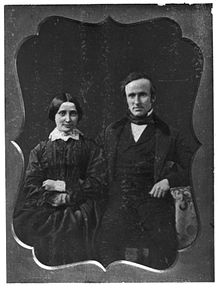
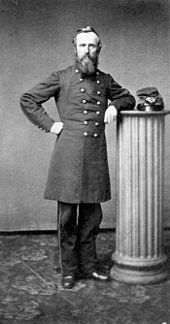

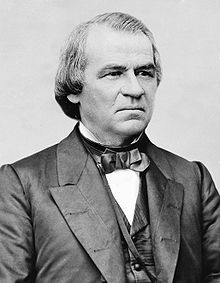
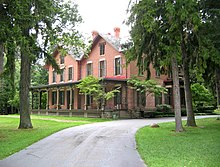

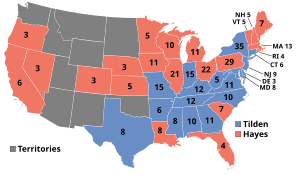

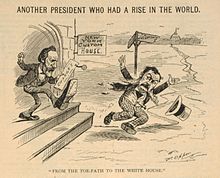
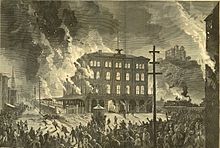
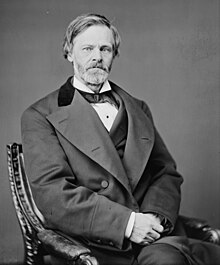
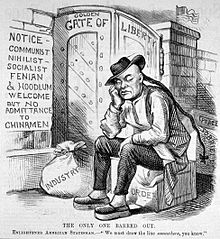




No comments:
Post a Comment